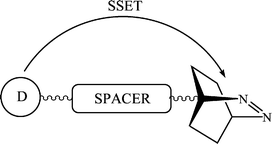Intramolecular singlet–singlet energy transfer in antenna-substituted azoalkanes
Abstract
Two novel azoalkane bichromophores and related model compounds have been synthesised and photophysically characterised. Dimethylphenylsiloxy (DPSO) or dimethylnaphthylsiloxy (DNSO) serve as aromatic donor groups (antenna) and the azoalkane 2,3-diazabicyclo[2.2.2]oct-2-ene (DBO) as the acceptor. The UV spectral window of DBO (250–300 nm) allows selective excitation of the donor. Intramolecular singlet–singlet energy transfer to DBO is highly efficient and proceeds with quantum yields of 0.76 with DPSO and 0.99 with DNSO. The photophysical and spectral properties of the bichromophoric systems suggest that energy transfer occurs through diffusional approach of the donor and acceptor within a van der Waals contact at which the exchange mechanism is presumed to dominate. Furthermore, akin to the behaviour of electron-transfer systems in the Marcus inverted region, a rate of energy transfer 2.5 times slower was observed for the system with the more favourable energetics, i.e. singlet–singlet energy transfer from DPSO proceeded slower than from DNSO, although the process is more exergonic for DPSO (−142 kJ mol−1 for DPSO versus −67 kJ mol−1 for DNSO).


 Please wait while we load your content...
Please wait while we load your content...